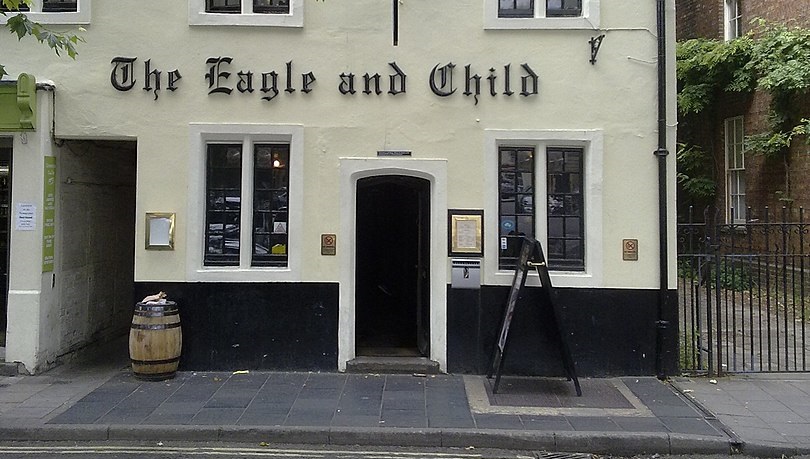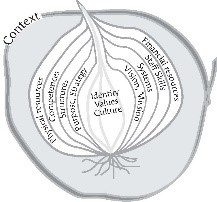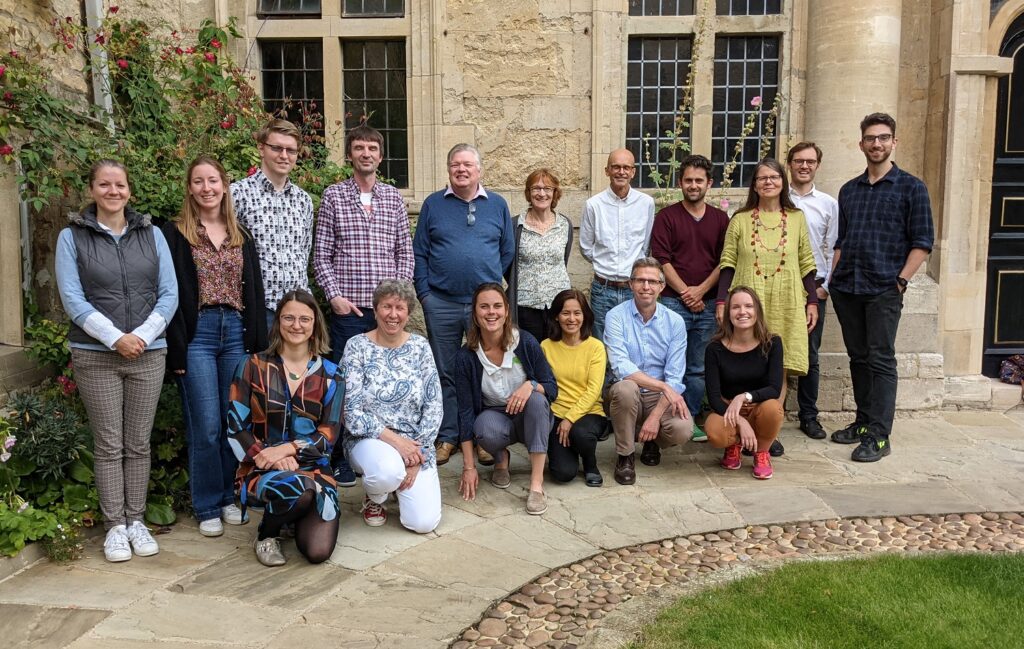Founding of INTRAC
INTRAC (the International NGO Training and Research Centre) was officially founded in November 1991 when it was registered as a charity. It also became a Company Limited by Guarantee the following year. This turned an idea into a reality.
Before INTRAC
The 1980s might have been known as ‘The NGO Decade’ due to the rapid growth of the sector, but there were some notable gaps. There was virtually no in-service training available for NGO staff on such topics as project design, monitoring and evaluation or organisational capacity building. In those pre-internet days, there were few publications for reflective NGO practitioners. Written products were restricted to practical guidelines at one end of the spectrum (e.g. how to dig a well) and at the other end more academic material produced by university departments (e.g. on development theory), but there was little in between for the average NGO worker. It tended to be governments that set agendas for debates on development policy and there was limited collective voice from NGOs on the issues of the day.
Developing the INTRAC idea
In other words, there was an INTRAC-shaped hole. A conference organised in 1989 under the auspices of Oxfam in Swansea resulted in a book – Evaluating Social Development Projects – and showed the potential for bringing together committed individuals and like-minded organisations. This led to consultation meetings in Oxford and Brussels. Interestingly there seemed to be more enthusiasm at this point from across the Channel than in the UK, underlining that INTRAC is as much European in character as it is British. A collective view emerged that INTRAC should be independent (and not part of a larger organisation) if it was to play an effective convening role for others.
Following a meeting in the Friends Meeting House, St Giles, Oxford, Brian Pratt, Alan Fowler and John Hailey adjourned to the nearby Eagle and Child – the same pub where ‘inklings’ JRR Tolkien and CS Lewis used to discuss their own fantasy worlds – and INTRAC was born. They were later joined by the fourth ‘founder’, Piers Campbell, with each contributing some of their own money to get the concept off the ground. Without financial backing, INTRAC had to be ‘lean and mean’ – only doing work it could get funded and keeping costs to a minimum.

Getting started
The first Director was Brian Pratt, previously of Oxfam. There were doubters in those early days who felt that he could never succeed. A combination of an unwavering belief in the ideas behind INTRAC, an entrepreneurial spirit, the ability to translate contacts into opportunities (whether over a glass of red wine or in a Swedish sauna), and sheer bloody-mindedness proved them all wrong.
But of course, an organisation is about more than one individual. INTRAC has involved many others – founders, Board and other staff (now around 20 in number). Another crucial ingredient over the years has been the INTRAC Associates. Defining an Associate has always been hard, but Associates are not employed by INTRAC, work frequently on consultancies and write materials. More than this, Associates see INTRAC as a valuable vehicle for promoting civil society strengthening and contribute to its thinking and wellbeing. The footprint of INTRAC can partly be seen where ‘EXTRAC’ people (whether interns, staff or associates) have ended up – in donor agencies, other INGOs, local organisations or operating independently – still promoting many of the same ideas and principles.
INTRAC publications
The first piece of INTRAC work was a study commissioned by the Dutch NGO Novib, which was published as INTRAC’s first book: Institutional Development and NGOs in Africa: Policy Perspectives for European Development Agencies. This was a concrete embodiment of a key INTRAC aspiration: bridging theory and practice. Since then there have been many other books, briefing papers and more recently blogs on a wide range of issues. The Praxis Programme supported by the Dutch Foreign Ministry (2003-7) generated a new form of INTRAC documentation in the form of an extensive series of Praxis Papers and Praxis Notes focused on distilling learning from practice. These were (and still are) geared towards, and in many cases written by, practitioners. From 2010 until the end of 2020, INTRAC was responsible for the editorship of Development in Practice, one of the best-known journals in the development sector.
INTRAC training
The second piece of INTRAC work was a training organised by Rick James, who is still with the organisation today. Back then, there were virtually no courses specifically for NGO staff and materials had to be developed from scratch. In one early instance, two INTRAC trainers got into a furious debate over the difference between ‘organisational development’ and ‘institutional development’ and the session had to be adjourned while they thrashed it out. Training was initially carried out in countries such as Denmark, Sweden and the Netherlands, before returning to Oxford. Bringing together participants from diverse backgrounds is often cited as one of INTRAC’s strengths as a training provider.
An analysis of open training over the past 10 years revealed there were on average of 200 participants per year, of whom roughly a quarter each come from the UK, continental Europe, Sub Saharan Africa and the rest of the world. In recent years, INTRAC introduced online training as an alternative to face-to-face courses. This pioneering work paid off when COVID-19 struck in 2020, when all courses were moved online. Tailor-made training commissioned by organisations for their own staff or partners have also become increasingly significant. INTRAC’s training often acts as a crucial first contact with organisations and individuals, which can then lead to other engagements.

INTRAC Geographical Programmes
In the mid-1990s, UNV asked INTRAC to carry out a consultancy in Kyrgyzstan. In those early cash-strapped days, INTRAC’s attitude to new opportunities was summarised by the phrase: ‘Yes, we’ll do it. What is it?’
In this instance, when the phone rang, it was more a case of ‘Yes, we’ll do it. Where is it?’ and a staff member duly hurried down to the bookshop to buy a map of Central Asia. In the immediate aftermath of the collapse of the Soviet Union, not only was the geography of the region little known to outsiders, but the very idea of civil society was weakly developed in the newly independent countries. There followed a series of consultancies and programmes in the region supporting local organisations. During 2002-5, INTRAC had offices in Almaty and Tashkent, as well as the regional office, in Bishkek which was established in 1997 and continues today. As ever with INTRAC, the aggregated impact of all this work is hard to measure, but when disturbances in Osh, Kyrgyzstan, in 2010 called for a major relief response, it was notable that many of the key local NGOs and development agencies had had close linkages with INTRAC.
There followed other geographically-based programmes in Malawi, Eastern Europe, Cyprus, Bangladesh and Ethiopia. These have enabled INTRAC to continue to bridge the theory-practice divide. INTRAC staff and associates get their ‘hands dirty’ putting ideas into practice on the ground together with local partners. In the process they develop learning, which feeds back into publications and new capacity building ideas.
NGO Research Programme
INTRAC has never had much by way of core income (and there is always some suspense around the annual financial results), but the nearest it came to unrestricted funding was an invaluable early grant in 1993 of £30,000 from the Aga Khan Foundation (UK). As this grant came to an end, it was replaced by persuading six European INGOs to contribute £5,000 per year each for INTRAC to carry out research on jointly agreed issues. The resulting research was presented at twice-yearly Forums and frequently published. The Research Programme ran until 2015, with a range of INGOs taking part, when changing needs and funding squeezes made the programme unviable. Its legacy remains in INTRAC’s catalogue of books, resources and conference outputs.
INTRAC research
Research has always been a key element of INTRAC’s work and identity. In some ways, it is what makes the organisation an NGO rather than a consultancy firm. While it draws on existing literature and academic debates, INTRAC’s research has always sought to be ‘practitioner-facing’ – relevant and useful to people working on the ground.

INTRAC has sometimes been ahead of the game in its research, but even when it was not innovating, it has often managed to catch the wave at the right moment, develop thinking and communicate in an easily understood way to its target audience. Many will be familiar with the ‘three circles’ or the ‘onion’ as ways of understanding and analysing an organisation.
Important topics INTRAC covered in the early days included challenging ‘mainstream’ (i.e. donor-led) thinking on monitoring and evaluation, at a time when many were pushing cost-benefit analysis with much less emphasis on participation and unexpected changes. INTRAC’s knowledge in this area was synthesised by Associate Nigel Simister and others in the form of The M&E Universe – a free, online resource developed by INTRAC for development practitioners.
Other important topics over the years have included exploring relationships between NGOs and the private sector, urban development, the impact of counter-terrorism measures on civil society after 9/11, critiquing the Paris agenda and, more recently, sustainability in the face of aid withdrawal. Sometimes INTRAC has been controversial. There is one description of a meeting to present research findings, where half the audience was horrified and the other half was delighted at the criticisms being laid at the door of some official donors: ‘you say the things we cannot say’.
INTRAC’s model
INTRAC has always been something of a hybrid. It seeks to strike a balance between various polarities. It bridges academic theory and practical experience. It is a charitable NGO, but also a business that now delivers over 100 contracted pieces of work a year. It champions local organisations, but has depended to a great extent on Northern-based INGOs and donors. It challenges the aid system on which it largely relies. It emphasises the importance of long term planning, while often working opportunistically itself.
Received wisdom on strategic planning states that organisations should define their role more clearly and specialise to become more effective. For INTRAC, it could be said that the opposite is true: its strength comes from straddling a number of themes and working methods, while remaining relatively small. Culturally, it has tended to suit individuals who like working on their own initiative, rather than requiring a lot of support. In practical terms, INTRAC people are simply too busy to provide close supervision. But however hectic things are, biscuit time at 3:30 on Friday remains a sacrosanct INTRAC institution (moved online during COVID-19) and epitomises the collegial side of the organisation.
While diverse, INTRAC has always been underpinned by a unifying set of values, which grew out of the initial vision. At its heart is the belief that, as an NGO itself, INTRAC is unashamedly ‘for civil society’ and sees civil society as intrinsically important, not just a vehicle to deliver others’ programmes. Through all its work, INTRAC aims to be a catalyst, facilitating rather than imposing change. It has always championed national organisations to be strong, independent and sustainable, rather than driven by external forces. They should take ownership of their own development, embracing responsibility for addressing their own challenges. As part of this, INTRAC has always championed and cooperated with like-minded local capacity building providers, such as long-term partners like PRIA and WACSI.
In financial terms, INTRAC resembles the myth about the bumble bee: according to the principles of aerodynamics, it should not be able to fly, but somehow it does. With no core financing, INTRAC’s existence has always been precarious, surviving on the income it can generate through contracts and grants. More lucrative areas of work cross-subsidise important but less profitable activities. In the mid-2000s, INTRAC suffered heavy losses for a couple of years and its very existence was threatened. With the support of the Board, there was serious belt-tightening – sub-letting half the office space, painful staff redundancies, and concerted efforts from those remaining to find more paying work.

INTRAC today and in the future
The world has changed a lot over the past 25 years. From International Development Targets in the 1990s (IDTs), we have moved from the Millennium Development Goals (MDGs) to the Sustainable Development Goals (SDGs). Aid budgets are increasingly under pressure and a huge range of actors are now involved in ‘development’ in the ‘global south’ – terms which we increasingly struggle with.
Where INTRAC once focused on ‘NGOs’, now we see ourselves as more about ‘CSOs’ (Civil Society Organisations). Understanding of the sector broadened in the 1990s to include local community groups, faith organisations, trade unions and social movements. More recently new forms of civil society have started to emerge such as on-line groups, while many question the role of INGOs in international development. In the area of civil society strengthening, where INTRAC once had a relatively clear field, other training providers, consultants, platforms and publications have proliferated.
The Shift the Power movement has challenged the aid system as a whole to question the traditional approach whereby resources, decision-making and power have been wielded in the global North.
Can INTRAC stay relevant and solvent under such circumstances? There can never be a final answer to this question. INTRAC must continue to evolve and develop ideas in response to the shifting sands. With new areas of work, such as the Consultants for Change programme to develop cadres of local consultants in the global South to support civil society and our contributions to civil society support programmes, there are still niches that play to INTRAC’s particular strengths and are overlooked by others. We continue to fill that INTRAC-shaped hole.
INTRAC’s impact
It is hard to summarise the difference INTRAC has made in the years since it was founded. INTRAC works indirectly to support others through a combination of training, consultancy, programmes and publications making it hard to measure its aggregated impact in absolute terms. One can always point to feedback forms, programme evaluations or revised donor mechanisms as evidence of INTRAC’s footprint. One can point to our significant portfolio of contracts and projects, or our increased turnover, as indicators of the continuing demand for INTRAC’s services. But perhaps more graphically, INTRAC’s contribution can be seen in the stories of the individual people and organisations it has affected in numerous ways.
Sitting in an airport in Papua New Guinea, one INTRAC Associate was waiting forlornly for a delayed plane. He turned to a woman on the bench next to him and they got talking. When he said he was with INTRAC, she immediately beamed in recognition. INTRAC, she declared, is the only organisation producing material relevant to her work with an NGO in Papua New Guinea, which contains such high quality analysis and is freely and easily downloadable.
That a small organisation in Oxford can have such influence half a world away is a testament to that vision that took shape in a pub 30 years ago.